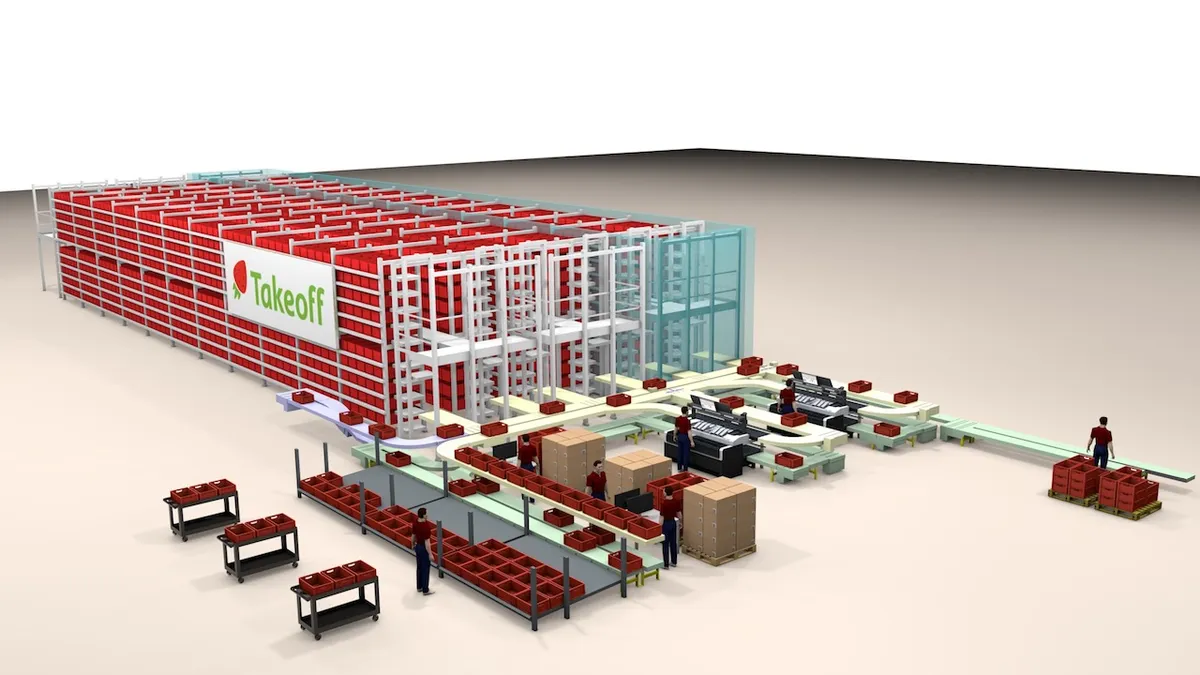Dive Brief:
- Boston-based Takeoff Technologies is developing small, heavily automated grocery distribution facilities that can quickly assemble orders for delivery or customer pickup in less than an hour. The company received $12.5 million in funding earlier this year and has plans to launch its first micro fulfillment center with a yet-to-be-named grocery store in October.
- The initial fulfillment center uses about 10,000 square feet of the grocery store’s 50,000 square foot space, according to Fast Company. Because of the model’s smaller footprint, it has plans to hook onto other locations, such as convenience stores, as well as offer a “hub and spoke” model that can support dozens of additional pickup locations such as quick-service restaurants and drug stores.
- To use the service, customers place their grocery order on the app, where it is received in the automated warehouse full of robots that gather the items and place them in bins. Those bins are then transported to the workstation, where the order is placed in bags by an attendant, who delivers the order to the customer in the pickup area. The customer alerts the attendant to their presence by tapping the app.
Dive Insight:
The race to find an efficient, convenient and fast fulfillment system in the grocery space is heating up as Takeoff Technology joins a growing list of companies seeking new solutions. Others include Tel Aviv-based CommonSense Robotics, who received $6 million in funding in 2017 to build a better fulfillment center, as well as Kroger, who has partnered with Ocado to boost its e-commerce.
These moves are for good reason. Research from the Food Marketing Institute and Nielsen indicate that demand for online grocery shopping is accelerating. In as little as four years, the industry could see $100 billion in sales and have 70% penetration.
Despite this pace, players in the space are mostly unprepared. Overall just 7% of retailers claim they have the culture or skills needed to succeed in omnichannel selling, according to Nielsen and Dialogic findings. The existing Instacart model may need to evolve in order to compete with automated services, which seem to have far more benefits, such as lower consumer costs, faster speed and higher accuracy.
Takeoff Technologies said its automated orders should take less than an hour and, ideally 30 minutes, which could potentially save a family about 60 hours a year. Speed may not be the only benefit. The company's “hub and spoke” model makes pick-up more convenient with a locker system in a number of locations from fast food restaurants to a location en route to work. In addition, completing fulfillment duties in a dedicated space won't disrupt a retailer’s day-to-day business from in-store customers like the Instacart and Shipt models. Unlike those two players, Takeoff promises no fees.
Smaller retailers may also benefit from the automation method Takeoff, CommonSense and San Francisco-based Farmstead by saving grocers labor costs and time. As more automated fulfillment warehouses open, more customers will likely get used to the benefits of its speed, potentially pushing companies like Instacart to evolve its business model to meet demand.








